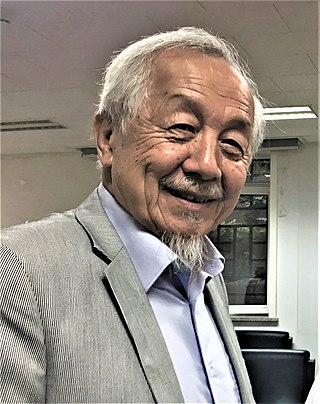American English, sometimes called United States English or U.S. English, is the set of varieties of the English language native to the United States. English is the most widely spoken language in the United States and in most circumstances is the de facto common language used in government, education and commerce. Since the late 20th century, American English has become the most influential form of English worldwide.

In linguistics, the comparative method is a technique for studying the development of languages by performing a feature-by-feature comparison of two or more languages with common descent from a shared ancestor and then extrapolating backwards to infer the properties of that ancestor. The comparative method may be contrasted with the method of internal reconstruction in which the internal development of a single language is inferred by the analysis of features within that language. Ordinarily, both methods are used together to reconstruct prehistoric phases of languages; to fill in gaps in the historical record of a language; to discover the development of phonological, morphological and other linguistic systems and to confirm or to refute hypothesised relationships between languages.
A lexicon is the vocabulary of a language or branch of knowledge. In linguistics, a lexicon is a language's inventory of lexemes. The word lexicon derives from Greek word λεξικόν, neuter of λεξικός meaning 'of or for words'.
The following outline is provided as an overview and topical guide to linguistics:
In phonology and linguistics, a phoneme is a unit of phone that can distinguish one word from another in a particular language.
Phonetics is a branch of linguistics that studies how humans produce and perceive sounds, or in the case of sign languages, the equivalent aspects of sign. Linguists who specialize in studying the physical properties of speech are phoneticians. The field of phonetics is traditionally divided into three sub-disciplines based on the research questions involved such as how humans plan and execute movements to produce speech, how various movements affect the properties of the resulting sound, or how humans convert sound waves to linguistic information. Traditionally, the minimal linguistic unit of phonetics is the phone—a speech sound in a language which differs from the phonological unit of phoneme; the phoneme is an abstract categorization of phones, and it is also defined as the smallest unit that discerns meaning between sounds in any given language.
Phonology is the branch of linguistics that studies how languages or dialects systematically organize their phones or, for sign languages, their constituent parts of signs. The term can also refer specifically to the sound or sign system of a particular language variety. At one time, the study of phonology related only to the study of the systems of phonemes in spoken languages, but may now relate to any linguistic analysis either:
A sound change, in historical linguistics, is a change in the pronunciation of a language. A sound change can involve the replacement of one speech sound by a different one or a more general change to the speech sounds that exist, such as the merger of two sounds or the creation of a new sound. A sound change can eliminate the affected sound, or a new sound can be added. Sound changes can be environmentally conditioned if the change occurs in only some sound environments, and not others.
General American English, known in linguistics simply as General American, is the umbrella accent of American English spoken by a majority of Americans, encompassing a continuum rather than a single unified accent. In the United States it is often perceived as lacking any distinctly regional, ethnic, or socioeconomic characteristics, though Americans with high education, or from the North Midland, Western New England, and Western regions of the country are the most likely to be perceived as using General American speech. The precise definition and usefulness of the term continue to be debated, and the scholars who use it today admittedly do so as a convenient basis for comparison rather than for exactness. Other scholars prefer the term Standard American English.

The voiceless alveolar lateral fricative is a type of consonantal sound, used in some spoken languages. The symbol in the International Phonetic Alphabet that represents voiceless dental, alveolar, and postalveolar lateral fricatives is, and the equivalent X-SAMPA symbol is K.
Language convergence is a type of linguistic change in which languages come to resemble one another structurally as a result of prolonged language contact and mutual interference, regardless of whether those languages belong to the same language family, i.e. stem from a common genealogical proto-language. In contrast to other contact-induced language changes like creolization or the formation of mixed languages, convergence refers to a mutual process that results in changes in all the languages involved. The term refers to changes in systematic linguistic patterns of the languages in contact rather than alterations of individual lexical items.
Language change is variation over time in a language's features. It is studied in several subfields of linguistics: historical linguistics, sociolinguistics, and evolutionary linguistics. Traditional theories of historical linguistics identify three main types of change: systematic change in the pronunciation of phonemes, or sound change; borrowing, in which features of a language or dialect are altered as a result of influence from another language or dialect; and analogical change, in which the shape or grammatical behavior of a word is altered to more closely resemble that of another word.
The Neogrammarians were a German school of linguists, originally at the University of Leipzig, in the late 19th century who proposed the Neogrammarian hypothesis of the regularity of sound change.
Philadelphia English is a variety or dialect of American English native to Philadelphia and extending into Philadelphia's metropolitan area throughout the Delaware Valley, including southeastern Pennsylvania, counties of northern Delaware, the northern Eastern Shore of Maryland, and all of South Jersey, with the dialect being spoken in cities such as Wilmington, Atlantic City, Camden, Vineland, and Dover. Philadelphia English is one of the best-studied types of English, as Philadelphia's University of Pennsylvania is the home institution of pioneering sociolinguist William Labov. Philadelphia English shares certain features with New York City English and Midland American English, although it remains a distinct dialect of its own. Baltimore English is a closely related dialect or sub-dialect, which exists on a geographic dialect continuum with Philadelphia English and is prevalent in nearby Baltimore and its metropolitan area. Philadelphia and Baltimore accents or dialects together constitute what Labov describes as a single "Mid-Atlantic" regional dialect.
A diaphoneme is an abstract phonological unit that identifies a correspondence between related sounds of two or more varieties of a language or language cluster. For example, some English varieties contrast the vowel of late with that of wait or eight. Other English varieties contrast the vowel of late or wait with that of eight. This non-overlapping pair of phonemes from two different varieties can be reconciled by positing three different diaphonemes: A first diaphoneme for words like late, a second diaphoneme for words like wait, and a third diaphoneme for words like eight.

Middle Korean is the period in the history of the Korean language succeeding Old Korean and yielding in 1600 to the Modern period. The boundary between the Old and Middle periods is traditionally identified with the establishment of Goryeo in 918, but some scholars have argued for the time of the Mongol invasions of Korea. Middle Korean is often divided into Early and Late periods corresponding to Goryeo and Joseon respectively. It is difficult to extract linguistic information from texts of the Early period, which are written using adaptations of Chinese characters. The situation was transformed in 1446 by the introduction of the Hangul alphabet, so that Late Middle Korean provides the pivotal data for the history of Korean.
The Atlas of North American English: Phonetics, Phonology and Sound Change is an overview of the pronunciation patterns (accents) in all the major regional dialects of the English language spoken in urban areas of the United States and Canada. It is the result of a large-scale survey by linguists William Labov, Sharon Ash, and Charles Boberg. Speech data was collected, mainly during the 1990s, by means of telephone interviews with individuals in metropolitan areas in all regions of the U.S. and Canada. Using acoustic analysis of speech from these interviews, ANAE traces sound changes in progress in North American English, and defines boundaries between dialect regions based on the different sound changes taking place in them.

Standard Canadian English is the largely homogeneous variety of Canadian English that is spoken particularly across Ontario and Western Canada, as well as throughout Canada among urban middle-class speakers from English-speaking families, excluding the regional dialects of Atlantic Canadian English. Canadian English has a mostly uniform phonology and much less dialectal diversity than neighbouring American English. In particular, Standard Canadian English is defined by the cot–caught merger to [ɒ](listen) and an accompanying chain shift of vowel sounds, which is called the Canadian Shift. A subset of the dialect geographically at its central core, excluding British Columbia to the west and everything east of Montréal, has been called Inland Canadian English. It is further defined by both of the phenomena that are known as Canadian raising : the production of and with back starting points in the mouth and the production of with a front starting point and very little glide that is almost in the Prairie Provinces.
In the sociolinguistics of the English language, raising or short-a raising is a phenomenon by which the "short a" vowel, the TRAP/BATH vowel, is pronounced with a raising of the tongue. In most American and many Canadian English accents, raising is specifically tensing: a combination of greater raising, fronting, lengthening, and gliding that occurs only in certain words or environments. The most common context for tensing throughout North American English, regardless of dialect, is when this vowel appears before a nasal consonant.

William Shi-Yuan Wang is a linguist, with expertise in phonology, the history of Chinese language and culture, historical linguistics, and the evolution of language in humans. He is Chair Professor at The Hong Kong Polytechnic University, Emeritus Professor of the University of California, Berkeley, and Academician of Academia Sinica.







